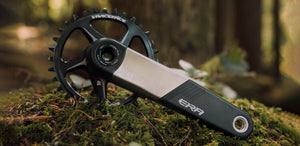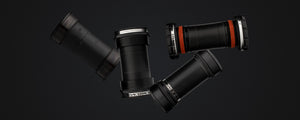Crank Selection Guide
Choosing the right Race Face crankset for your bike

Ready to upgrade your old cranks to something shiny and new? Assembling a brand-new custom bike build? While it may seem as simple as picking a crank arm length and hitting the buy button, there’s actually a bit more to it than that. Not to worry, we’re here to guide you through the process of picking the right crank for your bike and making sure it all fits with your frame and drivetrain.
1. Select the right spindle length and chain ring
TLDR: For most trail and all-mountain bikes, the recommended length is 136mm for 30mm diameter spindles and 137mm for 24mm diameter spindles. What chainring model you select—and whether you need to deviate from the 136/137mm spindle length—depends on your bike’s chainline.

Example spindle lengths for Race Face Cranks in 30mm diameter (from left; Era, Turbine and Atlas) and 24 mm diameter (Aeffect R)
There are a few factors that influence the required spindle length for your bike’s frame. The first is frame clearance. The cranks arms and chain ring need to spin freely with ample clearance of your frame’s chainstays. Another is Q-Factor (the distance between your feet on the pedals in the horizontal plane), which influences rider ergonomics. As crank makers, Q-Factor is something we optimize at Race Face to be narrow enough for pedaling comfort while staying wide enough for frame clearance.
The third factor is chainline. This is the distance from your front chainring to the center line of the bike’s frame in the horizontal plane. Chainline determines the alignment of your front chainring and your rear cassette, which will affect shifting performance and chain wear.
Basically, you’re looking for the narrowest Q-Factor while maintaining ample frame clearance and getting as close as possible to your bike’s recommended chainline.

Typical chainline of 52mm with the RF136 Spindle on a 148mm (Boost) frame
Still with us? Good. By the end of this guide, you’ll be a self-professed know-it-all on crank selection.
The most common chainlines on modern bike frames are somewhere between (or close to) 52mm and 55mm. Bikes with 148mm boost hub spacing can be found with both 52mm and 55mm chainlines, while bikes with 157mm Super Boost hub spacing are most often found with 55mm chainlines (for more information and how to identify your rear hub spacing, see the Appendix at the end of this article). You should be able to find your bike’s chainline on the manufacturer's website, but it may require a bit more digging beyond the initial specification table. For example, for the 2023 Trek Fuel EX, the chainline information can be found on the final page of the Service Manual PDF. If you can’t find the chainline information, we’d recommend giving your frame manufacturer a call and letting them dig it up.
That all said, if you are fitting a reasonably modern trail or all-mountain bike with Race Face cranks, the 136mm 30mm diameter (136mm 30ø for short) or 137mm 24mm diameter (137mm 24ø) spindle will get you close to your desired chainline while maintaining the most ideal Q-factor possible. Zeroing in on your ideal chainline then comes down to chainring selection, which we’ll cover next.
For downhill bikes (or bruiser bikes built for more gravity applications such as shuttling and bike park), riders may opt for the burlier construction of the Atlas or SixC cranks. These models only ship with a stronger (and slightly heavier) downhill spindle in either 136mm or 151mm size. The Race Face DH136 spindle will work best for 148 Boost spacing and the 151mm spindle will work best for 157 Super Boost spacing.
2. Select the right chainring for your chosen spindle length
If your bike is designed around the common 52mm chainline, we recommend you select the 136mm (30ø) or 137mm (24ø) spindle and use a standard direct mount chainring like the Direct Mount SHI-12 if you run a 12-speed Shimano drivetrain. If you run another type of drivetrain such as an 11-speed Shimano or SRAM Eagle 12-speed, a Race Face Cinch Direct Mount Narrow Wide chain ring (or a compatible Cinch Narrow Wide chainring from another manufacturer) will deliver the best results for shifting and chain wear.

On a Devinci Troy Carbon (157 Super Boost) running a Shimano 12-speed drive train, the Turbine crank with 136mm spindle paired with Cinch Direct Mount Wide SHI-12 chainring will offer the ideal chainline of around 55mm.
If your bike is designed around a 55mm chainline (like that found on many bikes with Super Boost 157mm hub spacing) and you run a Shimano 12-speed drivetrain, we recommend you select a 136mm (30ø) or 137mm (24ø) spindle and use the Direct Mount Wide - SHI 12 chainring. If you do not run a Shimano 12-speed drivetrain but still want to get as close as possible to that 55mm chainline, you can select a 136mm (30ø) or 137mm (24ø) spindle and find a compatible 0° offset chainring from another component manufacturer.
3. Identify your current Bottom Bracket Shell Width and Type
Now let’s take a look at your bike’s Bottom Bracket (BB). This is the component that secures your crank spindle in place inside the frame and allows your cranks to spin. Unfortunately, the bike industry has accumulated quite a few different (and competing) BB standards over the years which can add to consumer confusion. But we’ll do our best to keep it as simple as possible.

The BB type and shell size can be usually found in the spec table on the manufacturer’s website
Look at the spec table on your bike manufacturer’s website, (again, you may need to look at the bike’s technical data) and search for the line that says, “Bottom Bracket.” We won’t go into all the different BB standards, but it should have a code associated with it. Here are some examples of what you may find:
SRAM DUB | BSA | 83mm
Shimano PF92
Shimano SM-BB52, 73mm, threaded external bearing
BSA 73mm
Race Face BB92 30mm
The number within the code (or sometimes specified as a millimeter value next to it) is the BB’s shell size. Typical values for the shell size are 68, 73, 92, 89.5, 104.5 and 107 mm. If you also see a smaller number or measurement such as 24mm or 30mm, that’s the spindle diameter the BB can accommodate.

Threaded or Press Fit? That depends on your bike's frame.
BBs also fall into two camps; Threaded and Press Fit. Any of the above BB examples that have “PF” in the code are press fit type, meaning the BB cups are pressed into the frame with a headset tool (or any type of pressing tool you have available). If there is no “PF” in the code or it mentions “threaded,” the BB is threaded into the frame and tightened using a bottom bracket tool.
Do you need a new BB to fit your new Race Face cranks?
Turbine, Era, Next SL, Atlas and SixC cranksets are only manufactured with 30mm diameter spindles.
Aeffect, Aeffect R and Ride cranksets are only manufactured with 24mm diameter spindles.
The question is, can your current BB accommodate your required spindle diameter? In most cases, there’s no way to tell without pulling apart your crankset and measuring it with a set of vernier calipers.

Bottom Brackets come in different sizes and types for different bike frames
30mm Spindles (Era, Turbine, Next SL, Atlas or SixC)
Some of the BB brands that accommodate 30mm spindles are Race Face, Chris King, Hope and Wheels Manufacturing. If you don’t have one of these brands of BB, you will likely need to purchase a new BB to fit your new Era, Turbine, Next SL, Atlas or SixC crankset.
If your bike is running a Shimano Hollowtech or SRAM DUB bottom bracket, your new Era, Turbine, Next SL, Atlas or SixC crankset cranks will NOT fit. Shimano and SRAM have their own spindle diameter standards. If you have one of these BBs installed, you will need to change up your BB if you want to run a 30mm spindle Race Face crank.
If your bike has a few seasons on it or you ride a lot in wet conditions, it’s probably a good time to replace your BB anyway. Those bearings don’t have infinite lifespans! Race Face manufactures four BBs that accommodate 30mm spindle (three Press Fit, one threaded). You can also source a BB from one of the brands listed above that accommodate 30mm spindles.
Here are the four 30ø BBs made by Race Face:
24mm Spindles (Aeffect, Aeffect R, Ride)
If your bike is currently running Shimano cranks, you will likely be running a 24mm diameter Shimano Hollowtech BB. Race Face Aeffect, Aeffect R and Ride cranks use 24mm spindles so they will slide right into that Shimano BB no problem.
If your bike is currently running SRAM DUB (or SRAM GXP on older bikes) BB and cranks, your new Aeffect, Aeffect R or Ride crankset WILL NOT fit. You will need to change up your BB if you want to run a 24mm spindle Race Face crank. As we mentioned before, it may be a good time to replace your BB anyway. Race Face manufactures three BBs that accommodate 24mm spindle (two Press Fit, one threaded). You can also source a BB from one of the brands listed above that accommodate 24mm spindles.
Still unsure whether your Race Face cranks will fit your bike? We couldn’t cover every possible scenario or configuration of BBs and spindles in this guide, so if you need more advice, get in touch with us or check with the staff at your local bike shop. If you bought a Race Face crank with the correct spindle length and chainring for your hub spacing, your Local Bike Shop should be able to grab the right BB off the shelf (supply-dependent, of course) and install it for you.
Appendix - Identify your rear hub spacing
Rear hub spacing. This is the distance between the frame dropouts where your rear wheel sits, the same as the length of your rear axle. This information can be usually found on your bike brand’s website, or you can use a ruler or measuring tape. If you’re one of those folks who like to be absolutely sure, check both! When checking your brand’s website look for your bike model (make sure to specify the model year, since frame designs will often get updated in certain years) then look at the specification table. Read what it says for “rear hub” or “rear axle.” You may need to look further into the bike’s technical data. The spec should read something like the following:
Rear wheel axle: 148 x 12 mm
These are rear hub spacing (148) and axle diameter (12) values
Rear Hub: Novatec DH92SB-SH TA 12x157 SH
While there are quite a few confusing part numbers for the Novatec hub here, the ones of note are 12 x 157 indicating rear hub spacing (157) and axle diameter (12)

An example of a bike spec table on the manufacturer’s website
The most common rear hub spacing on modern all-mountain, trail and enduro bikes is 148mm, otherwise known as “Boost.” The next most common rear hub spacing is 157mm, otherwise known as “Super Boost.” This can be found on most Downhill bike frames but also on a growing number of all-mountain, trail and enduro frames.